Hog farming leads the sector
Final results of the 2010 Annual Survey of Philippine Business and Industry (ASPBI) showed that the country had a total of 1,536 establishments engaged in agriculture, forestry and fishing in the formal sector of the economy.
Hog farming led the sector with 336 establishments, accounting for 21.9 percent of the total number of establishments. Growing of sugarcane including muscovado sugar-making in the farm ranked second with 252 or 16.4 percent. Commercial ocean fishing, (using vessels over 3 tons) and chicken broiler production followed with 141 establishments (9.2%) and 103 establishments (6.7%), respectively. Other leading industries in terms of number of establishments were as follows:
- Growing of paddy rice, lowland, irrigated, 96 establishments (6.3%)
- Growing of cavendish banana, 94 establishments (6.1%)
The remaining 33.4 percent (514 establishments) of the total were engaged in other agricultural activities.
Figure 1 shows the percentage distribution of all agriculture, forestry and fishing establishments by industry sub-class in 2010.

Growing of cavendish banana employs the highest number of workers
Total employment of all agriculture, forestry and fishing establishments reached 137,248 in 2010. Of the total workforce, 98.7 percent were paid employees and the remaining 1.3 percent were working owners and unpaid workers.
Employment generated by top two industries comprised more than half (51.5%) of the total. Growing of cavendish banana emerged as the top employer with 41,173 workers or 30.0 percent of the total employment, followed by growing of sugarcane including muscovado sugar-making in the farm with 29,565 workers (21.5%). In third place, commercial ocean fishing (using vessels over 3 tons) provided jobs to 15,291 workers, accounting for 11.1 percent of the total employment. Hog farming, despite ranking highest in number of establishments, hired only 8,624 workers or 6.3 percent of the total.
Figure 2 shows the top ten employers for all agriculture, forestry and fishing establishments by industry sub-class in 2010.
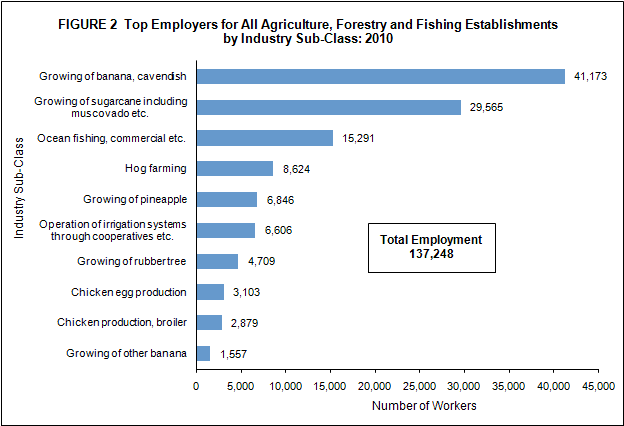
The average number of workers per establishment for the sector was recorded at 89. At the industry-level, growing of pineapple recorded the highest ratio with 456 workers per establishment, followed closely by growing of cavendish banana with 438 workers per establishment. Services to establish crops, promote their growth and protect them from pests and diseases came in third with 403 workers per establishment.
Employees in services to establish crops, promote their growth and protect them from pests and diseases earn the highest average annual compensation
Total compensation paid by all agriculture, forestry and fishing establishments in 2010 amounted to PHP16.9 billion, equivalent to an average annual compensation of PHP124,549 per employee.
Of the total compensation paid in 2010, about half (46.2%) was contributed by growing of cavendish banana, amounting to PHP7.8 billion. This was followed far behind by commercial ocean fishing (using vessels over 3 tons) with PHP1.8 billion (10.6%).
The highest average annual compensation of PHP366,587 was received by employees in services to establish crops, promote their growth and protect them from pests and diseases. Employees in growing of corn, except young corn (vegetable), were the second highest earners, with average annual compensation of PHP264,216, followed by employees in growing of leafy and stem vegetables with average pay of PHP259,879 annually.
Figure 3 shows the average annual compensation of employees for all agriculture, forestry and fishing establishments by industry sub-class in 2010.
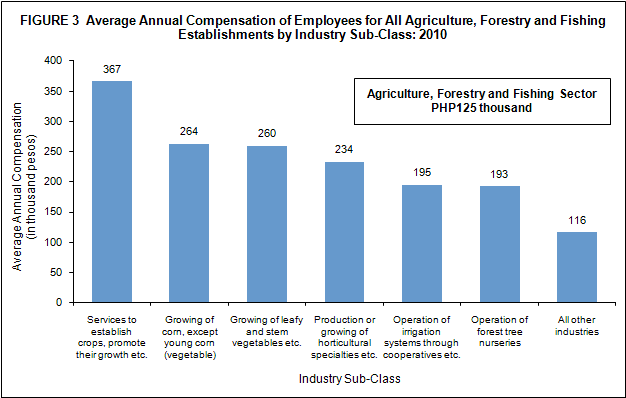
Growing of cavendish banana generates highest value of output
In 2010, the value of output generated by all agriculture, forestry and fishing establishments reached PHP86.2 billion.
More than one third (38.2%) or PHP32.9 billion of the total value of output was generated by establishments engaged in growing of cavendish banana, the highest among industries. Hog farming and commercial ocean fishing (using vessels over 3 tons) followed with respective shares of 13.7 percent (PHP11.8 billion) and 12.6 percent (PHP10.9 billion).
Figure 4 shows the percentage distribution of value of output for all agriculture, forestry and fishing establishments by industry sub-class in 2010.

Total cost reaches PHP66.7 billion
Total cost, excluding compensation, incurred in 2010 by all agriculture, forestry and fishing establishments in business operation summed up to PHP66.7 billion.
Five industries accounted for 75.9 percent of the total cost for the sector. Growing of cavendish banana, having the highest value of output, also incurred the highest cost amounting to PHP25.8 billion. Hog farming ranked second with PHP9.9 billion, followed by commercial ocean fishing (using vessels over 3 tons) with PHP8.9 billion. Chicken broiler production and growing of pineapple spent PHP3.9 billion and PHP2.1 billion, ranking fourth and fifth, respectively.
Revenue per cost stands at 1.31
The ratio of total revenue to total cost in 2010 was 1.31, which implies that for every peso spent PHP1.31 was realized in terms of revenue.
By industry, growing of rubber tree registered the highest revenue per peso cost of 3.18. This was followed by growing of coconut, including copra-making, tuba gathering and coco-shell charcoal making in the farm with 2.94. Other top industries in terms of revenue-cost ratio were:
- Seaweeds farming, 2.35
- Growing of paddy rice, lowland, irrigated, 2.05
- Catching fish, crabs and crustaceans in inland waters, 2.00
Growing of cavendish banana accounts the highest value added
Value added generated by all agriculture, forestry and fishing establishments was estimated at PHP34.4 billion in 2010.
Among industries, value added of the top three industries accounted for more than half (56.5%) of the total, recording a combined amount of PHP19.4 billion. Growing of cavendish banana contributed the biggest share with PHP13.2 billion or 38.3 percent of the total. Commercial ocean fishing (using vessels over 3 tons) placed second with PHP3.4 billion or 9.9 percent, followed by hog farming with PHP2.9 billion or 8.3 percent. The value added of other leading industries were listed below.
- Growing of sugarcane including muscovado sugar-making in the farm, PHP1.8 billion (5.4%)
- Growing of pineapple, PHP1.8 billion (5.3%).
- Chicken broiler production, PHP1.8 billion (5.3%)
- Operation of irrigation systems through cooperatives and non-cooperatives, PHP1.8 billion (5.2%)
Growing of corn, except young corn (vegetable) records the highest productivity
Ratio of value added to employment, a measure of labor productivity, was recorded at PHP250,820 per worker in 2010.
Labor productivity of the top three industries surpassed one million mark. The highest labor productivity was recorded for growing of corn, except young corn (vegetable) valued at PHP1.9 million per worker. Preparation of crops for primary markets and chicken layer production, followed with PHP1.3 million each.
Figure 5 shows the labor productivity for all agriculture, forestry and fishing establishments by industry sub-class in 2010.
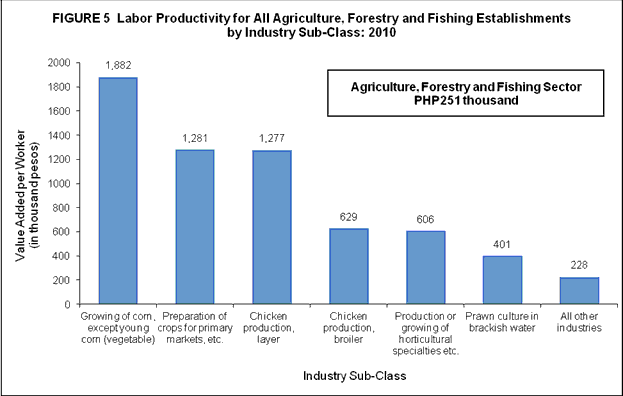
Gross addition to tangible fixed assets totals to PHP4.9 billion
Gross addition to tangible fixed assets, defined as capital expenditures less sale of fixed assets, acquired by all agriculture, forestry and fishing establishments was estimated at PHP4.9 billion in 2010.
Operation of irrigation systems through cooperatives and non-cooperatives and growing of cavendish banana with PHP1.2 billion each, accounted for almost half (49.5%) of the total gross addition to tangible fixed assets. Other top contributors for the sector in terms of gross addition to fixed assets were the following:
- Ocean fishing, commercial (using vessels over 3 tons), PHP590.8 million (12.2%)
- Hog farming, PHP251.7 million (5.2%).
- Production or growing of horticultural specialties and nursery products, PHP249.3 million (5.1%)
Subsidies received from the government amounts to PHP622.8 million
Subsidies granted by the government to all agriculture, forestry and fishing establishments amounted to PHP622.8 million in 2010.
By industry, services to establish crops, promote their growth and protect them from pests and diseases received the highest subsidies with PHP585.0 million or 93.9 percent of the total. Hog farming was a far second with PHP20.0 million (3.2%), followed by pearl culture with PHP10.1 million (1.6%).
TECHNICAL NOTES
Introduction
This Special Release presents the final results of the 2010 Annual Survey of Philippine Business and Industry (ASPBI) for the Agriculture, Forestry and Fishing sector.
The 2010 ASPBI is one of the designated statistical activities of the National Statistics Office (NSO) with the objective of providing key measures on the levels, structure, trends and performance of economic activities in the country. As such, the survey generates the most critical and essential statistics required for economic planning and policies. It was conducted in April 2011 with year 2010 as the reference period of data, except for employment which is as of November 15, 2010.
The 2009 Philippine Standard Industrial Classification (PSIC) was adopted for the first time in this survey. This is the latest version of the classification of industries in the country which conforms with the International Standard Industrial Classification Revision 4 prescribed by the United Nations.
Data are presented at the industry sub-class or 5-digit 2009 PSIC, national level.
The agriculture, forestry and fishing sector is composed of 157 industry sub-classes but only 61 industries were covered in the 2010 ASPBI. Industries not covered in the survey indicate that there are no establishments in the formal sector engaged in such activities.
Legal Authority
The conduct of the ASPBI is governed by legislative acts and presidential directives, mainly Commonwealth Act No. 591 which was approved on August 19,1940. Other legislative acts are:
- Presidential Decree No. 418
- Executive Order No. 121
- Executive Order No. 352
- Executive Order No. 5
Scope and Coverage
The 2010 ASPBI covered establishments engaged in 18 economic sectors classified under the 2009 PSIC, namely:
- Agriculture, Forestry and Fishing (A)
- Mining and Quarrying (B)
- Manufacturing (C)
- Electricity, Gas, Steam, and Air Conditioning Supply (D)
- Water Supply; Sewerage, Waste Management and Remediation Activities (E)
- Construction (F)
- Wholesale and Retail Trade; Repair and Maintenance of Motor Vehicles, Motorcycles (G)
- Transportation and Storage (H)
- Accommodation and Food service activities (I)
- Information and Communication (J)
- Financial and Insurance Activities (K)
- Real Estate Activities (L)
- Professional, Scientific and Technical Activities (M)
- Administrative and Support Service Activities (N)
- Education (P)
- Human Health and Social Work Activities (Q)
- Arts, Entertainment and Recreation (R)
- Other Service Activities (S)
The survey was confined to the formal sector of the economy, which consists of the following:
- Corporations and partnership
- Cooperatives and foundations
- Single proprietorship with employment of 10 and over
- Single proprietorships with branches
Unit of Enumeration
Like all other establishments surveys conducted by the NSO, the 2010 ASPBI unit of enumeration is the establishment. The establishment is defined as an economic unit under a single ownership or control which engages in one or predominantly one kind of activity at a single fixed location.
Methodology
Sampling Design
The 2010 ASPBI used stratified systematic sampling with five-digit PSIC serving as first stratification variable and TE as the second stratification variable.
Estimation Procedure

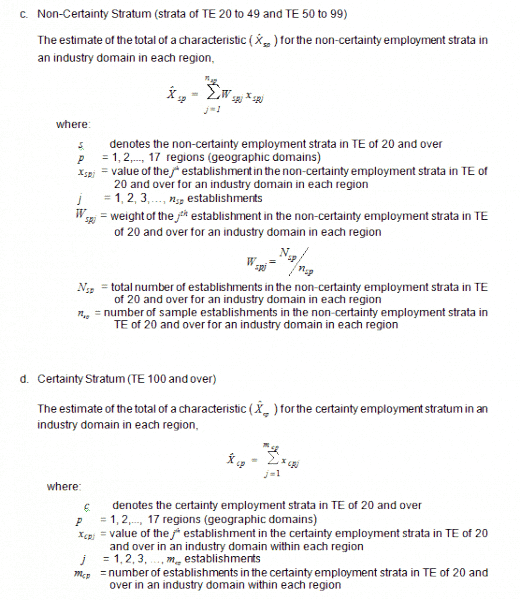
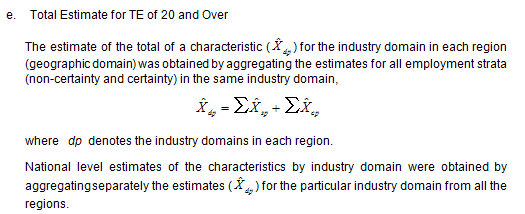
Response Rate
The response rate is 97.4 percent (792 out of 813 establishments). These include receipts of "good" questionnaires, partially accomplished questionnaires, reports of closed, moved out or out of scope establishments.
Concepts and Definitions of Terms
Economic activity is the establishment’s source of income. If the establishment is engaged in several activities, its main economic activity is that which earns the biggest income or revenue.
Total employment is the number of persons who worked in for the establishment as of November 15, 2010.
Paid employees are all persons working in the establishment and receiving pay, as well as those working away from the establishment paid by and under the control of the establishment. Included are all employees on sick leave, paid vacation or holiday. Excluded are consultants, home workers, receiving pure commissions only, and workers on indefinite leave.
Compensation includes salaries and wages, separation/retirement/terminal pay, gratuities, and payments made by the employer in behalf of the employees such as contribution to SSS/GSIS, ECC, PhilHealth, Pag-ibig, etc.
Revenue includes cash received and receivables for goods/products and by-products sold and services rendered. Valuation is at producer prices (ex-establishment), net of discounts, and allowances, including duties and taxes but excluding subsidies.
Cost refers to all expenses incurred during the year whether paid or payable. Valuation is at purchaser prices including taxes and other charges, net of rebates, returns and allowances. Goods and services received by the establishment from other establishments of the same enterprise are valued as though purchased.
Intermediate cost refers to expenses incurred in the production of goods such as materials and supplies purchased, fuels purchased, electricity purchased, and agricultural/forestry/fishery and industrial services done by others plus beginning inventory of materials, supplies and fuels less ending inventory of materials, supplies and fuels.
Value of output represents the sum of the receipts from products and by-products sold, agricultural/forestry/fishery services rendered, industrial services, and goods sold in the same condition as purchased less the cost of goods sold; and value of fixed assets produced on own account and change in inventories of finished products and work-in-progress.
Value added is gross output less intermediate cost. Gross output for the agriculture, forestry and fishing sector is value of output plus non-industrial services done for others (except rent income from land). Intermediate input is intermediate cost plus non-industrial services done by others (except rent expense for land) and other costs.
Gross addition to tangible fixed assets is equal to capital expenditures less sale of fixed assets, including land.
Inventories refer to the stock of goods owned by and under the control of the establishment as of a fixed date, regardless of where the stocks are located. Valuation is at current replacement cost in purchaser prices. Replacement cost is the cost of an item in terms of its present price rather than its original cost.
Change in inventories is equivalent to the value of inventories at the end of the year less the value of inventories at the beginning of the year.
Subsidies are all special grants in the form of financial assistance or tax exemption or tax privilege given by the government to aid and develop an industry.
